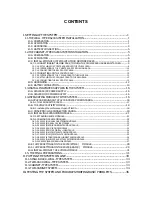
QX50/QX200/QX2000; (SW Version 6.0.x)
15
QX50/QX200/QX2000 Manual III: Extension User’s Guide
By entering Permanent Call Back reconfiguration menu, system asks caller to login by dialing the number and an appropriate password for the QX IP PBX's
extension that is used as login extension in the Call Back settings. After passing the login, callers should follow the voice instructions for configuring a new
entry or reconfiguring existing entries in Authorized Phone database.
When system accepts the inserted settings, the corresponding entry will be logged to the Authorized Phones Database. The caller will then be
disconnected from the QX IP PBX's Auto Attendant and the defined Call Back destination will receive a call from the QX IP PBX within the next 45 seconds.
Answering the incoming call, the caller will be reconnected to the QX IP PBX's Auto Attendant.
Please Note:
The detected caller number must correspond to the one applied by the caller. In case of PSTN call back at least one PSTN line must be
available on the QX IP PBX. There must be network connectivity and the destination must be reachable.
Non-Permanent Call Back
Non-Permanent Call Back configuration service allows trusted caller to organize one-time Call Back to the defined destination. In this situation, no entry
will be logged to the Authorized Phones Database. By calling QX IP PBX's Auto Attendant and entering the Auto Attendant menu, the caller can use
menu (see
) to modify the Call Back destination for already registered callers in the Authorized Phones Database.
The system will ask to login by dialing the number and an appropriate password for the QX IP PBX's extension that is used as login extension in the Call
Back settings. After login, caller should follow the voice instructions for reconfiguring the existing entry in Authorized Phone database. The caller will then
be disconnected from the QX IP PBX's Auto Attendant and the defined Call Back destination will receive a call from the QX IP PBX within the next 45
seconds. Answering the incoming call, the caller will be reconnected to the QX IP PBX's Auto Attendant.
Please Note:
For both Permanent Call Back and Non-Permanent Call Back, the detected caller number must correspond to the one configured for trusted
caller. In case of PSTN call back at least one PSTN line must be available on the QX IP PBX. There must be network connectivity and the destination must be
reachable.
Call Routing Management Menu
This menu is used to manage the routing entries in the Call Routing table, i.e. to enable/disable certain dialing rules by dialing key combinations pre-
configured on each routing entry.
Dialing
at the Auto Attendant welcome message, will ask for an enabler/disabler key used to enable or disable the routing rule(s)
correspondingly. Since multiple routing rules may have the same enabler/disabler key combinations (the same key may be used as enabler for one routing
rule, and as disabler for another one), dialing the certain key will affect all pre-configured routing rules.
If the routing record has an authorization enabled on the enabler/disabler key, administrator’s password will be required to be inserted after the key.
Once the administrator’s password is dialed, system plays a confirmation about the accepted configuration and the state of the certain routing rule(s) is
getting modified.
If administrator’s password has been inserted incorrectly for 3 times, no status changes will be applied to any of the routing record(s), even to those which
have no authorization enabled.
Mainly targeting external users, QX IP PBX AA also provides voice services for local users. It will be helpful if the desired extension number is unknown.
The
Extensions Directory
is used to access QX IP PBX’s extensions by spelling names (assigned to the extensions and configured by administrator) using
the keypad of the phone. More than one name may be assigned to an extension, reaching the extension by spelling one of the names attached to it. If the
spelled name matches to some record in the extensions directory table, a wave file with the extension user name (or any other information characterizing
the extension’s user) will be played to the caller. Every extension’s user may configure these wave files individually.


































